The State Bank at New Brunswick NJ 1860’s $5 Remainder PMG 58 EPQ
$220.00This note from the State Bank At New Brunswick, New Jersey 1860’s $5 remainder features several vignettes.


This note from the State Bank At New Brunswick, New Jersey 1860’s $5 remainder features several vignettes.


The Series 1902 $5 dollar bill is one of the most common large national currency types. But, don’t let that fool you into thinking they’re worth little in value. National currency values are driven primarily by location and condition of the note. Dated August 13, 1903. The bank was chartered with the number 6956 in 1903.
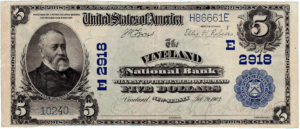

Discover a beautifully preserved large size note from a resilient New Jersey community that stands as a testament to its history. This large-size national currency was issued by a South Jersey bank, known for its distinctiveness amidst the backdrop of the First Charter Period. With only a baker’s dozen of surviving examples reported, this bright and well-margined note is in pristine condition, making it a rare gem for collectors. Experience the charm and significance of this tough yet elegant piece of South Jersey’s financial heritage.
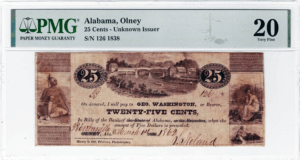
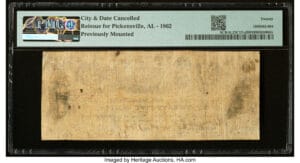
The Origin and Background of the 1838 Twenty-Five Cents Note The 1838 twenty-five cents note is a fascinating artifact that reflects not only the economic landscape of Alabama during its issuance but also the broader context of American currency in the 19th century. Originally issued in Olney, Alabama, the note holds significance as one of…
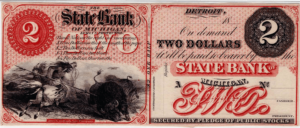

The $2 note stands out for its remarkable vignette depicting a Native American bison hunt. Such details make these notes a fascinating subject for collectors and history enthusiasts alike.
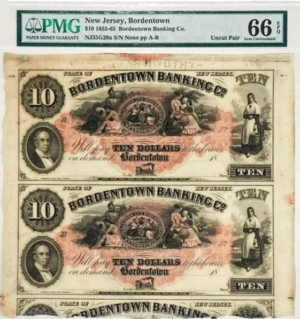

The Bordentown Banking Company The Bordentown bank was incorporated in 1851 and remained in business until at least 1904. This Uncut Pair of $10 Bordentown Banking Company notes were designed for use when the bank 1851 and 1854. They are printed by The American Banknote Company. An Impressive Design The design incorporates a center vignette…
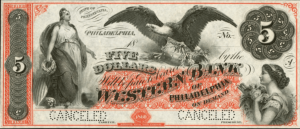

Beautifully designed by the National Bank Note Company, this bright red and black patriotic note captures the essence of America. Featuring an allegorical representation of the nation, it showcases a majestic bald eagle perched on a federal shield.
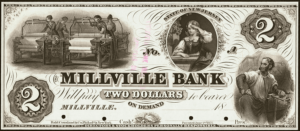

The 1857 Millville Bank $2 proof note is a remarkable artifact that encapsulates the artistic and cultural essence of its time. Characterized by intricate design elements, the note features ornate engravings and a delicate color palette, which were representative of the artistic sentiments prevalent in the mid-19th century.
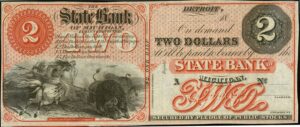

The $2 note stands out for its remarkable vignette depicting a realistic Native American bison hunt, complemented by a striking color palette of red and black. Such details make these notes a fascinating subject for collectors and history enthusiasts alike.


This note from the State Bank At New Brunswick, New Jersey 1860’s $1 remainder features several vignettes. The denomination top left and right($1), n the center, a vignette of a woman spinning wool, in the background there is a factory and a train. On the left, a train passing over a bridge, a farmer harvesting hay and a boat in the water. On the right, various agricultural products and tools.
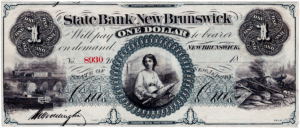

This note from the State Bank At New Brunswick, New Jersey 1860’s $1 remainder features several vignettes. The denomination top left and right($1), n the center, a vignette of a woman spinning wool, in the background there is a factory and a train. On the left, a train passing over a bridge, a farmer harvesting hay and a boat in the water. On the right, various agricultural products and tools.
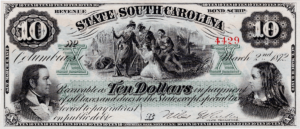

1872 South Carolina $10 Revenue Bond Note SCCR7 Dated March 2nd, 1872 with signature of the State Treasurer Niles G. Parker The 1872 South Carolina $10 Revenue Bond Note is a highly sought-after collectible among paper money enthusiasts. Issued during a tumultuous period in American history, namely Reconstruction. These notes offer a glimpse into the…
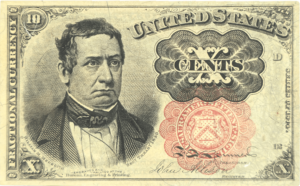
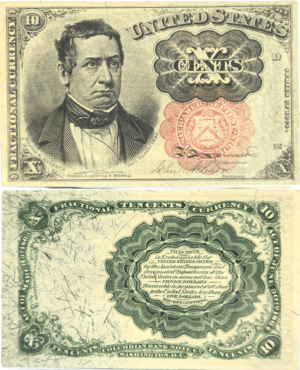
This ten cent fractional note, identified as the fifth issue F-1265, represents a captivating chapter in American currency history. Issued during the fifth series of fractional currency, this note showcases exquisite design elements on both the obverse and reverse sides.
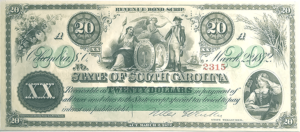

1872 South Carolina $20 Revenue Bond Note SCCR7 Dated March 2nd, 1872 with signature of the State Treasurer Niles G. Parker The 1872 South Carolina $20 Revenue Bond Note is a highly sought-after collectible among paper money enthusiasts. Issued during a tumultuous period in American history, namely Reconstruction. These notes offer a glimpse into the…
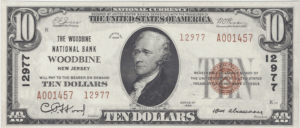

This rare $10 1929 Series Woodbine NJ National Bank Charter 12977 note is a must-have for any serious collector of local US currency. Issued by the National Bank of Woodbine, New Jersey, this piece of history features a rich deep green ink and classic design. With its unique serial number and engraved signatures, this banknote offers a peek into the financial landscape of rural New Jersey in the early 20th century.
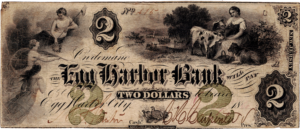

1861 Egg Harbor Bank Egg Harbor City New Jersey $2 Note featuring several vignettes. Liberty and two other goddesses at left, the denomination($2) adjacent, a woman feeding a calf at top center and people fording a river behind her. At bottom center a covey of quail.
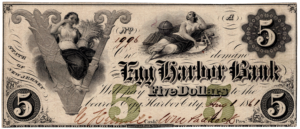

1861 $5 Egg Harbor Bank in Egg Harbor City NJ Note dates from August 1, 1861 and features vignettes of Ceres sitting in a large V and Navigation reclining, the denomination top right and two bottom corners.


Discover a rare piece of American history with the $20 1929 Series Phoenixville, PA National Bank Charter 1936, serial 547A. This unique note is a certified treasure, verified by PMG as Choice 58 EPQ, ensuring its quality and authenticity.
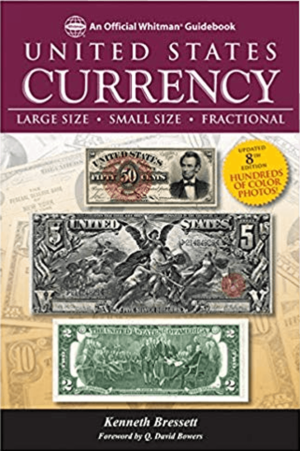

Discover the ultimate guide for collectors interested in the rich history and value of US paper currency with “A Guide Book of United States Paper Money 8th Edition.” Authored by renowned experts Arthur L. and Ira S. Friedberg, this comprehensive 420-page guide is a must-have resource for any enthusiast. With over 650 vibrant images, this eighth edition covers federal notes from the Civil War era to modern times, including rare treasures like Treasury Notes from the War of 1812, encased postage stamps, and Fractional Currency.